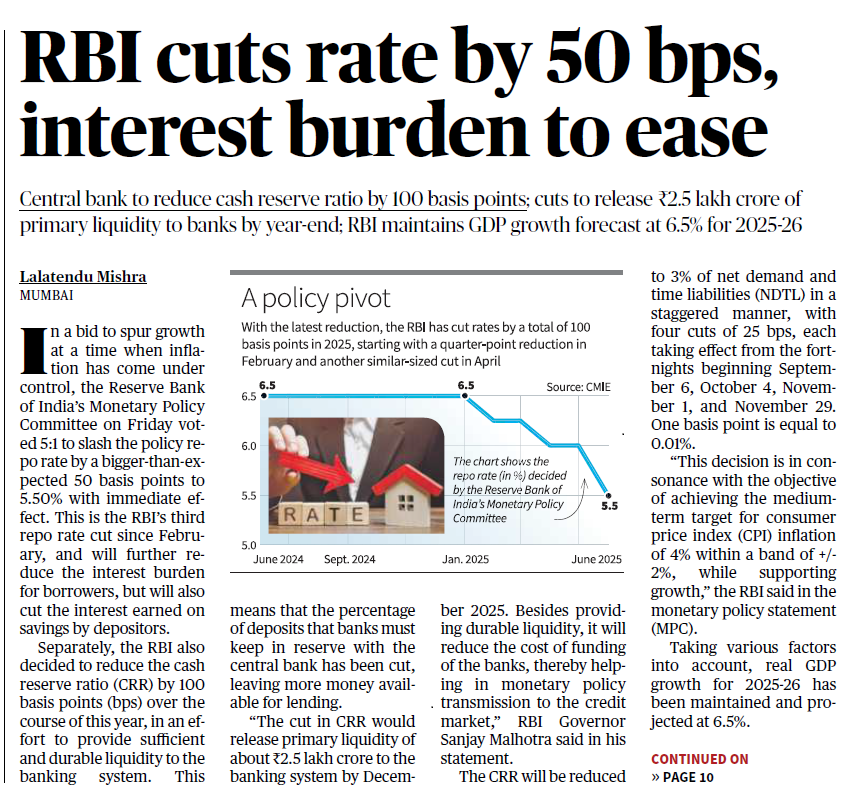
The Reserve Bank of India (RBI) has cut the repo rate by 50 basis points (bps) to 5.50% and decided to reduce the Cash Reserve Ratio (CRR) by 100 bps in a phased manner. These moves are aimed at boosting economic growth and improving monetary policy transmission amidst controlled inflation.
Repo Rate: The rate at which the RBI lends to commercial banks. A reduction makes loans cheaper.
Cash Reserve Ratio (CRR): The percentage of a bank’s total deposits that must be maintained with the RBI. Lower CRR increases lending capacity.
Basis Point (bps): One basis point = 0.01%. 50 bps = 0.50%.
- Repo Rate Cut:
- Reduced from 6.0% to 5.5% (a 50 bps cut).
- Third rate cut since February 2025.
- Decision passed by 5:1 majority in the Monetary Policy Committee.
- CRR Reduction:
- To be reduced by 100 bps in four stages (25 bps each).
- Will go from 4% to 3% of NDTL by Nov 2025.
- Expected to release ₹2.5 lakh crore into the banking system.
- Reason for Moves:
- To support economic growth.
- Inflation under control; CPI within RBI’s target range (4% ± 2%).
- Improve liquidity and reduce interest burden on borrowers.
- GDP Growth Forecast:
- Maintained at 6.5% for FY 2025–26.
- Inflation also forecast at 6.5%.
- Repo Rate Cut:
Consider the following statements regarding the recent monetary policy measures taken by the Reserve Bank of India (RBI) in 2025:
- The RBI has increased the Cash Reserve Ratio (CRR) to curb inflation.
- A 50 basis point repo rate cut was implemented to ease the interest burden on borrowers.
- The CRR cut is expected to inject ₹2.5 lakh crore into the banking system by end of 2025.
Which of the statements is/are correct?
A. 1 and 2 only
B. 2 and 3 only
C. 1 and 3 only
D. 1, 2 and 3
Answer: B. 2 and 3 only
- Statement 1 is incorrect: RBI has reduced, not increased, the CRR to boost liquidity.
- Statement 2 is correct: RBI cut the repo rate by 50 bps (0.5%) to reduce interest costs.
- Statement 3 is correct: RBI stated the CRR reduction would release ₹2.5 lakh crore into the banking system by December 2025.
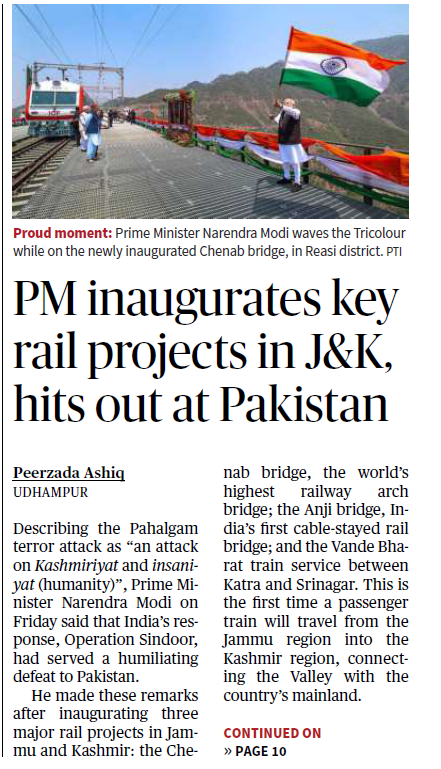
Prime Minister Narendra Modi inaugurated three major railway infrastructure projects in Jammu & Kashmir (J&K) and strongly condemned the recent Pahalgam terror attack, describing it as an assault on Kashmiriyat and Insaniyat. He stated that India’s swift response through Operation Sindoora served a major blow to Pakistan.
- Chenab Bridge:
- World’s highest railway arch bridge.
- Located over the Chenab River in Reasi district, J&K.
- Symbol of engineering excellence and strategic connectivity.
- Anji Bridge:
- India’s first cable-stayed railway bridge.
- Enhances connectivity in difficult terrain.
- Vande Bharat Train Service:
- First time a passenger train will operate between Katra and Srinagar.
- Connects the Jammu region with the Kashmir Valley, integrating the region with India’s railway network.
Operation Sindoora:
- A counter-terrorist operation launched in response to the Pahalgam terror attack.
- PM called it a “humiliating defeat” for Pakistan and a response to its cross-border terrorism.
- Emphasized values of Kashmiriyat (Kashmiri ethos) and Insaniyat (humanity).
Consider the following statements regarding recent rail infrastructure developments in Jammu and Kashmir:
- Chenab Bridge is the world’s highest railway suspension bridge.
- Anji Bridge is India’s first cable-stayed rail bridge.
- Vande Bharat train service will now connect Katra with Srinagar for the first time.
Which of the statements given above is/are correct?
A.1 and 2 only
B. 2 and 3 only
C. 1 and 3 only
D. 1, 2 and 3
Answer: B. 2 and 3 only
Statement 1 is incorrect: Chenab Bridge is the highest railway arch bridge, not a suspension bridge.
- Statement 2 is correct: Anji Bridge is India’s first cable-stayed railway bridge.
- Statement 3 is correct: The new Vande Bharat service connects Katra to Srinagar for the first time, linking Jammu with the Kashmir Valley.

An 800-year-old Shiva temple from the later Pandya period (1217–1218 CE) was unearthed at Udamapatti, Melur taluk, Madurai district, Tamil Nadu. This discovery provides valuable insight into the temple economy, religious architecture, and administrative practices of the Pandya dynasty
- The temple is dedicated to Lord Shiva.
- Unearthed remains include:
- Foundation base with intact northern and southern stone platforms.
- Two Tamil inscriptions dated 1217–1218 CE, deciphered by archaeologist C. Santhalingam.
- Supported by references from Silpa Sastra.
Location & Historical Identification:
- Present village: Udamapatti, Madurai.
- Ancient name: Attur.
- Waterbody mentioned: Thennavaniswaram (linked to the title “Thennavan” used by the Pandyas).
- Sale deed mentions a tank called Nagankulam.
Inscription Details:
- Records sale of waterbody + land by Alagaperumal, a chieftain of Kalavalinadu, to Nambi Perambala Kuthan alias Kangeyan.
- Price: 64 kasu (ancient coins).
- Four boundaries of the land clearly defined.
- Land tax was to be given to the God of Thennavaniswaram for daily temple expenses.
Significance:
- Religious & Cultural:
- Confirms the continued importance of Shaivism during the later Pandya period.
- Demonstrates the adherence to temple-building norms mentioned in ancient texts.
- Economic Insights:
- Indicates the existence of a self-sustaining temple economy.
- Tax used for temple maintenance reflects institutional financial autonomy.
- Socio-Administrative:
- Role of local chieftains and revenue officials in land transactions.
- Demonstrates sophisticated land governance and revenue systems.
Consider the following statements about the 800-year-old Shiva temple unearthed in Tamil Nadu in 2025:
- The temple is dedicated to Lord Vishnu and belongs to the Chola period.
- It was found in Udamapatti village in Madurai district.
- The inscriptions found refer to a sale of a waterbody and mention the use of ancient coins called kasu.
- The term “Thennavan” mentioned in the inscription was a title used by the Cheras.
Which of the statements are correct?
A) 1 and 4 only
B) 2 and 3 only
C) 2, 3, and 4 only
D) 1, 2, and 3 only
Answer: B) 2 and 3 only
Statement 1 is incorrect: The temple is dedicated to Lord Shiva, not Vishnu, and it belongs to the Pandya period. Statement 4 is incorrect: “Thennavan” was a title used by the Pandyas, not Cheras.
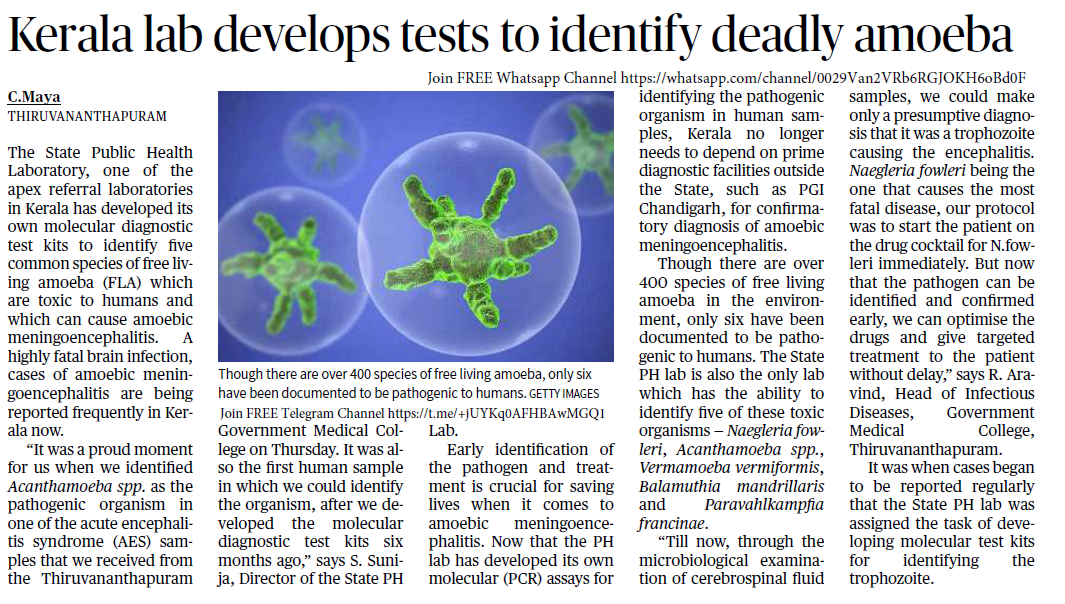
The State Public Health Laboratory (PH Lab) in Kerala has developed molecular diagnostic test kits to identify five species of free-living amoeba (FLA), responsible for the fatal brain infection called amoebic meningoencephalitis.
About Amoebic Meningoencephalitis
- A rare but deadly brain infection.
- Caused by pathogenic free-living amoeba entering the brain through the nasal passage (often during water exposure).
- Symptoms mimic other encephalitis-like conditions (AES).
What the Kerala Lab Has Achieved
- Developed molecular (PCR-based) diagnostic kits.
- Can now accurately identify 5 out of 6 known human-pathogenic FLA species.
- Earlier, only presumptive diagnosis was possible using CSF (Cerebrospinal Fluid) microscopy.
- Reduces dependency on external labs (e.g., PGI Chandigarh) for confirmation.
Pathogenic Amoeba Identified by Kerala Lab
- Naegleria fowleri (most fatal)
- Acanthamoeba spp.
- Vermamoeba vermiformis
- Balamuthia mandrillaris
- Paravahlkampfia francinae
- Kerala’s PH Lab is India’s only lab with this multi-species diagnostic capability.
Which of the following organisms can cause amoebic meningoencephalitis in humans?
A. Naegleria fowleri
B. Acanthamoeba spp.
C. Plasmodium vivax
D. Balamuthia mandrillaris
Choose the correct answer:
1 and 3 only
B. 1, 2 and 4 only
C. 2 and 3 only
D. All of the above
Correct Answer: B. 1, 2 and 4 only
Naegleria fowleri, Acanthamoeba spp., and Balamuthia mandrillaris are free-living amoeba (FLA) known to cause amoebic meningoencephalitis.
Plasmodium vivax is a malaria parasite, not an amoeba.
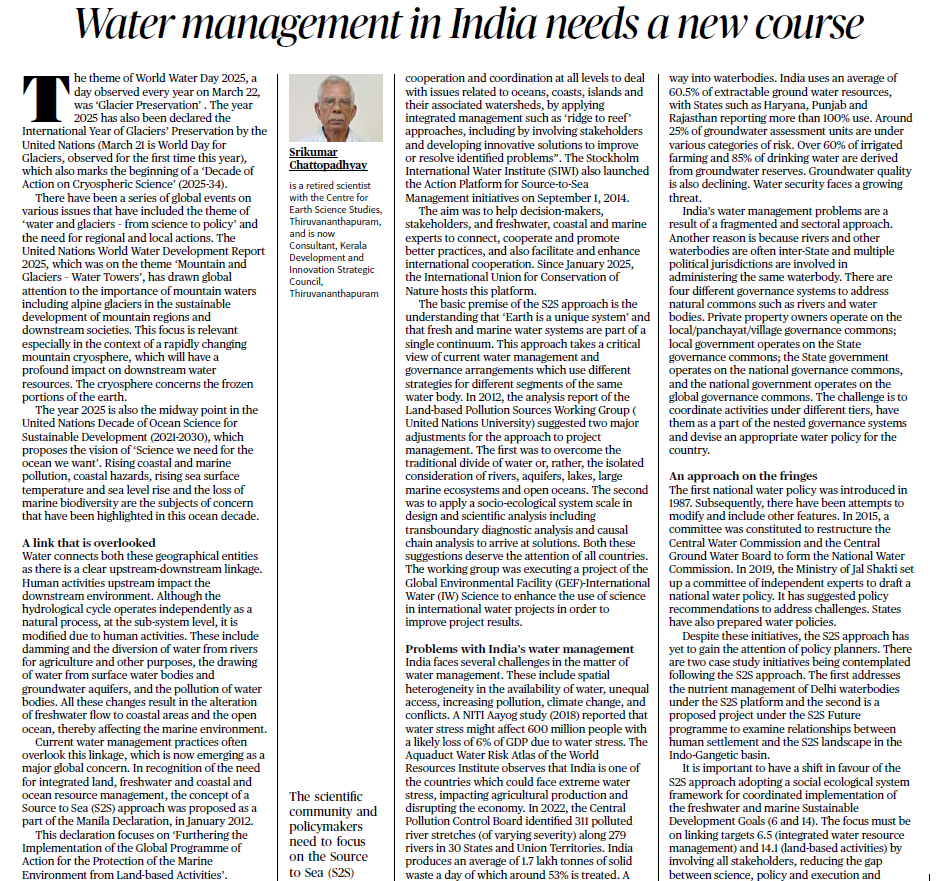
Why in News?
- World Water Day 2025 was observed on March 22, themed “Glacier Preservation”.
- Marks the beginning of the UN Decade of Action on Cryospheric Science (2025–2035).
- India’s water management strategy is under scrutiny due to increasing groundwater stress, urban water crises, and fragmented governance systems.
Global Context
- The United Nations World Water Development Report 2025 focuses on mountain water sources and glaciers (called Water Towers).
- Emphasis is on sustainable glacier and cryosphere management in light of climate change-induced melting and disrupted hydrological cycles.
- UNEP and Stockholm Environment Institute promote a Source-to-Sea (S2S) approach for integrated water governance.
Issues with Water Management in India
- Fragmented Institutional Approach:
- Multiple ministries and stakeholders.
- Lack of coordination across Centre–State–Local bodies.
- Excessive Groundwater Dependency:
- 63% of water needs met via groundwater.
- 85% of rural water and 60% of irrigation relies on it.
- Declining Water Quality:
- Contamination due to overuse and untreated waste.
- Unresolved Inter-State Water Disputes.
- Urban Water Stress:
- Rapid urbanisation not matched with water infrastructure.
Current Governance Framework
- India has four parallel governance regimes:
- Commons-based: Rivers, lakes.
- Private ownership: Wells, tube wells.
- Community-managed: Tanks, ponds.
- Government-managed: Centralised systems.
- Absence of a national integrated water law worsens the crisis.
- India has four parallel governance regimes:
Scientific Insights – Source to Sea (S2S) Approach
- Views the entire water cycle as connected – from glaciers → rivers → estuaries → oceans.
- Encourages catchment-to-coast planning.
- Recognised by the UN Ocean Conference 2022 for integrated and climate-resilient water governance.
- Links land-based activities (like pollution, waste) to marine outcomes.
Policy & Institutional Developments
- National Water Policy (2012): Limited impact.
- Ministry of Jal Shakti (2019) created to centralise water-related issues.
- Recent efforts:
- Namami Gange
- Urban sewage and wastewater recycling
- Coastal city water resilience programs
- Yet, silos persist in implementation.
Way Forward / Recommendations
- Enact a National Water Framework Law.
- Adopt Source-to-Sea approach at river basin level.
- Strengthen Centre–State–Local convergence.
- Promote community-based water governance.
- Focus on pollution control, recycling, and climate resilience.
- Improve data transparency and hydrological monitoring.
With reference to the Source-to-Sea (S2S) approach, consider the following statements:
- It connects the management of mountains, rivers, estuaries, and oceans as one integrated system.
- It has been endorsed by the UN Ocean Conference.
- It focuses exclusively on marine pollution and does not include land-based activities.
Which of the above statements is/are correct?
A) 1 and 2 only
B) 1 and 3 only
C) 2 and 3 only
D) 1, 2 and 3
Answer: A) 1 and 2 only
- The S2S approach views the entire hydrological cycle as interconnected.
- It was endorsed in the UN Ocean Conference 2022.
- It includes land-based activities like waste disposal and soil degradation, so statement 3 is incorrect.
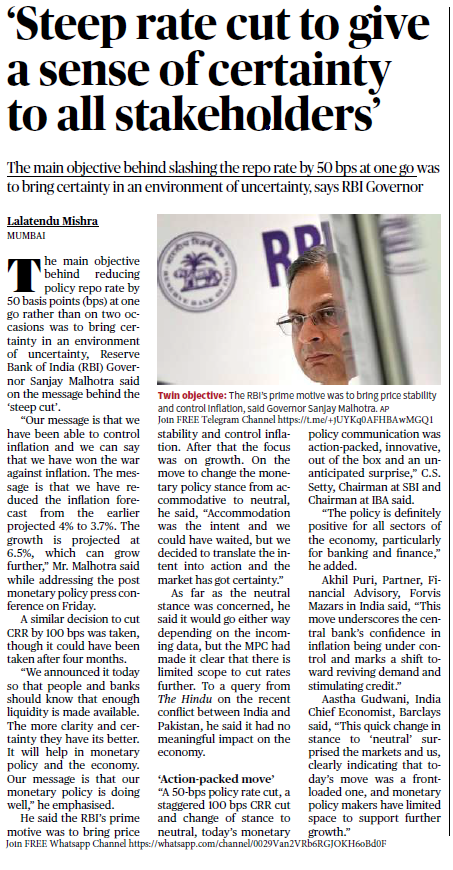
The Reserve Bank of India (RBI) recently reduced the repo rate by 50 basis points (bps) in a single move.
- Objective: Bring certainty in an environment of economic uncertainty.
Delivered by RBI Governor Sanjay Malhotra at the Monetary Policy Committee (MPC) meeting.
- Main Goal of the Rate Cut:
- Bring predictability and clarity for all stakeholders.
- Support growth without compromising inflation control.
- Economic Indicators Cited:
- Inflation moderated to 5.3%, from earlier 6.5% projection.
- Growth expected at 6.5%, which may be revised upward.
- Accommodative stance has now shifted to a neutral stance.
- Communications Strategy:
- Clear signalling to markets and public.
- RBI aims to avoid surprises and ensure policy transparency.
Monetary Policy Impact
- Rate cut tools: Repo rate reduced by 50 bps to lower borrowing costs.
- Brings:
- Cheaper loans for businesses and households.
- Stimulus to economic activity.
- Stability in investor and market sentiment.
Expert Commentary
- Analysts noted:
- A “surprise move” – but aligned with need for stimulus.
- Accommodative stance now replaced by a data-driven, neutral policy.
Way Forward
- Maintain balance between growth and inflation.
- Strengthen transmission of rate cuts to banks and NBFCs.
- Continuous communication to anchor market expectations.
- Use monetary tools with caution during global uncertainties.
What was the primary reason behind the RBI’s decision to cut the repo rate by 50 basis points, as per Governor Sanjay Malhotra?
A. To increase foreign investment
B. To promote exports
C. To bring certainty in an environment of uncertainty
D. To reduce fiscal deficit
Answer: C
The RBI Governor stated that the steep rate cut was aimed at bringing certainty to all stakeholders during a time of economic uncertainty.
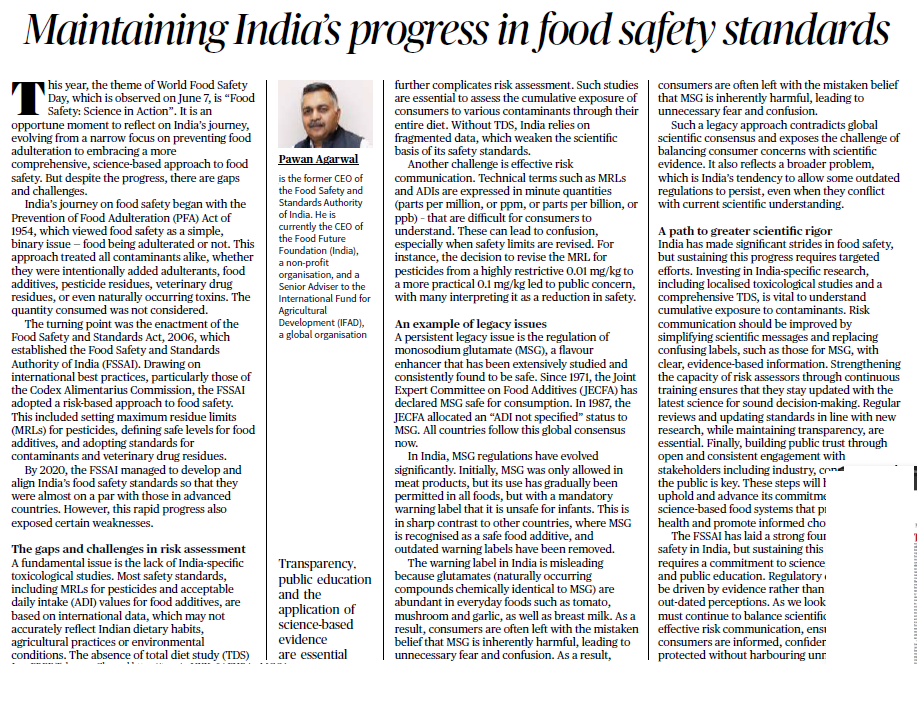
- World Food Safety Day observed on June 7, 2025.
- Theme: “Food Safety: Science in Action”.
- Article reflects on India’s evolving journey in food safety and the need for a more science-based, risk-oriented approach.
Year | Milestone | Significance |
|---|---|---|
1954 | PFA Act (Prevention of Food Adulteration Act) | Treated food safety as binary (adulterated vs non-adulterated); all contaminants treated alike. |
2006 | Food Safety and Standards Act (FSSA) | Established FSSAI; replaced PFA Act; adopted risk-based approach aligned with global Codex standards. |
2020 | Comprehensive alignment of Indian food standards | Development of standards for MRLs, food additives, contaminants, etc. |
Scientific & Technical Challenges
- Lack of India-specific toxicological studies.
- Absence of Total Diet Studies (TDS) – needed to assess cumulative exposure to contaminants.
- Reliance on international data that may not reflect Indian food habits/environment.
Legacy Misconceptions
- Misinterpretation of MRLs as absolute safety levels.
- Widespread (but scientifically incorrect) belief that Monosodium Glutamate (MSG) is harmful.
What Has Been Done?
- FSSAI’s reforms: Introduced scientific risk assessment, MRL setting, food additives regulation.
- Programs launched for scientific knowledge dissemination and capacity building.
- Adoption of Codex Alimentarius standards to align with global best practices.
Way Forward
Research & Data
- Conduct India-specific toxicological studies.
- Implement Total Diet Studies (TDS) to generate local data.
Risk Communication
- Correct misconceptions (e.g., MSG is not inherently harmful).
- Simplify and communicate food safety standards to the public.
Capacity Building
- Train risk assessors regularly.
- Keep scientific staff updated with latest developments.
Transparency & Trust
- Promote science-based regulations.
- Build public trust through accurate education and openness.
Which of the following correctly describes the significance of the Food Safety and Standards Act, 2006?
A. It continued the binary adulterated–non-adulterated view of food safety.
B. It established the Prevention of Food Adulteration Authority.
C. It introduced a risk-based approach to food safety in India.
D. It banned the use of Monosodium Glutamate (MSG) in food.
Correct Answer: C
The Food Safety and Standards Act, 2006 marked a paradigm shift in India’s food regulation by replacing the older PFA Act and adopting a risk-based, scientific approach to food safety. It led to the establishment of the FSSAI, which uses MRLs, food additive levels, and scientific data.
